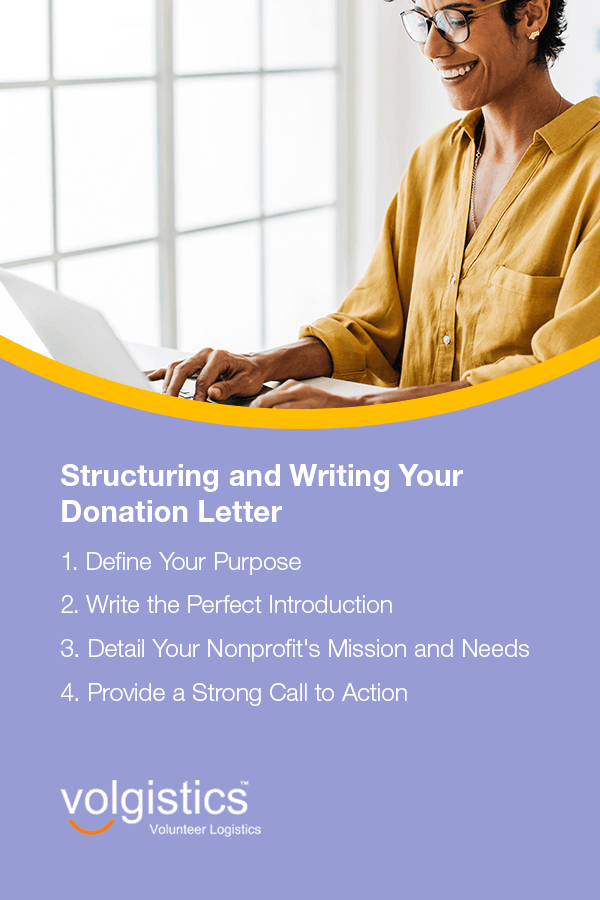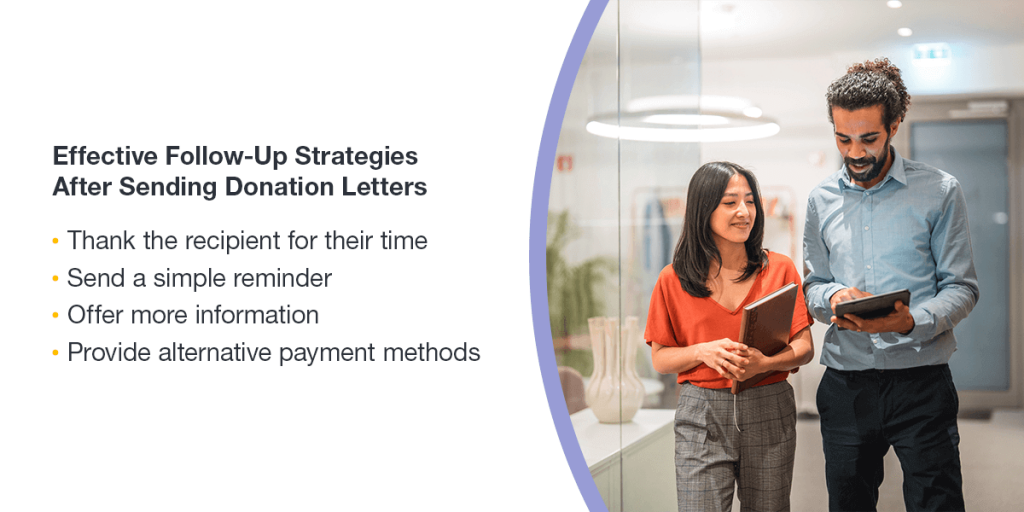Donation requests are core fundraising strategies and techniques for most nonprofits, but how you ask for support makes all the difference in your success. Letters make an impact by connecting with the reader, sharing the importance of your cause, and providing a direct, simple route for offering support.
You don’t have to be a prize-winning author to write an effective donation letter for a nonprofit organization, but you will need planning and a dash of creativity. This guide will walk you through the structure of a donation letter and tips for personalization, follow-up letters, and corporate recipients.
Structuring and Writing Your Donation Letter
A donation letter’s fundamental structure should be familiar if you’ve written other letters. Follow these steps for writing and using donation letters.
1. Define Your Purpose
Before writing anything down, determine what you want to accomplish with this letter. Consider factors like these.
- Type of donation: Are you looking for money, time, or in-kind donations? Knowing what you want can help you include more relevant details for your readers.
- Purpose of donations: Do you have a specific goal, such as funding an event or campaign, or are your fundraising efforts more generalized?
- Format: Emails are an affordable way to target specific audiences and reach many people, but direct mail offers a sense of intimacy that many appreciate.
- Length: The best donation letters are usually short and sweet. You might use a longer letter for an extensive campaign, but people typically prefer concise, easy-to-read content.

2. Write the Perfect Introduction
Once you know your goals, start crafting a stellar introduction. Focus on grabbing your readers’ attention with a hook. Some common approaches include using a question, quote, statistic, or story. Whatever method you use, try to make an immediate connection with humanistic, conversational language.
Two other elements to consider at the start of your letter include your salutation and subject line, if you’re sending an email. Use these to grab the reader’s attention, but be careful to avoid spammy-sounding language.
For your salutation, create a friendly greeting personalized to your reader. Many platforms can help you automatically populate an email with names from an imported spreadsheet or mailing list. Including the reader’s name rather than a generic “Dear Donor” greeting helps show that you see them as a person, not merely a source of funds.
3. Detail Your Nonprofit’s Mission and Needs
Next, tell your reader what you’re working on. Concisely describe your organization’s general goals and the project at hand. If you’re writing to a previous donor, this section is a good place to thank them and acknowledge their support.
After laying the groundwork, drive home the impact of the reader’s donation. Let them know the value of their time, money, or items, and explain how you used it. Share stories of people you’ve supported or describe your last campaign. Aim to create an emotional connection with the reader and tell them how you will use their donation to make an impact.
This part of the letter is your chance to tell a compelling story and connect with your audience. Pictures and videos can beautifully convey your impact by showing readers what your work looks like in action. Remember to emphasize how donations make it possible.
4. Provide a Strong Call to Action
This last component of your letter should make it as easy as possible for readers to donate. Provide an unmistakable, concise call to action that tells them what you’re looking for and shows them how to support you. You might ask for a specific dollar amount and provide a link to an online donation tool, or ask them to volunteer for only a few hours a week.
Providing a specific donation suggestion makes the process easier, since it reduces the decision-making the recipient must do. Instead of wondering if $20 is enough or thinking about the best way to donate, they can click a link and send money online.
Don’t forget to include a reminder that your organization appreciates any amount. The suggestion should make donating easier without discouraging smaller amounts. You can even offer choices, such as “Give $5,” “Give $10,” and “Give $15.” Research shows that this request style increases contributions by simplifying decisions.
If you’re sending out mailers instead of emails, you may need to provide more specific instructions, such as telling people to visit a URL or providing a mailing address for checks. You can also use a QR code to create and print an image users can scan with their phones.
How to Personalize Donation Letters to Increase Success Rates
A few personal touches can put your donation letters over the top. An easy way to personalize your donation requests is to segment your audience and send letters to people in specific categories. For example, you might send one letter to people who have never donated and another to thank recurring donors for their ongoing support.
Some ways to segment an audience include:
- Recurring versus one-time donors
- First-time versus high-amount donors
- Volunteers versus the public
- Interests
- Preferences for email versus physical mail
The Importance of Personalization For Non-Profit Organizations
Personalization can boost donation rates by making readers feel more connected to your organization. One of the easiest ways to personalize a letter is to add the recipient’s name, but you can also mention their previous interactions with your company. You might tell a frequent donor how much you appreciate their contributions or share with a volunteer how helpful their work has been.
People get donation requests from many organizations. Personalization can help you stand out by making the reader feel valued, boosting their connection to the organization.

Donation Request Letter Template for Nonprofits
Below is an example of a personalized donation letter for nonprofit organizations, written for previous donors:
Dear [donor name],
Did you know that [provide a statistic or fact about your mission]? On behalf of [your organization’s name], I’d like to ask for your support in our mission to [describe your purpose and values].
Your previous donations have enabled us to [describe one of your organization’s accomplishments from the last year]. We believe your contribution can help us make an even more significant impact. By supporting [your organization’s name], you will help us [describe how you plan to use this donation].
Please consider donating [specify an amount] today to directly benefit [name the community you serve]. We accept contributions through [list preferred donation methods or platforms], and we use every penny effectively and transparently. You can also contribute your time by volunteering. Please contact [name your volunteer manager] at [email or phone number] to get started!
If you have questions about our organization or how we use your contributions, please reach out! We wholeheartedly appreciate your consideration and support. Together, we can build a brighter future for [name the community you serve].
I sincerely thank you for your generosity,
[Your name] [Your title or role] [Your organization’s name]
Effective Follow-Up Strategies After Sending Donation Letters
Following up with your recipients is essential for getting many potential donors to finish the process. Sometimes, life gets in the way and they forget. Other times, they might be unsure if they want to donate, and your second request seals the deal. Whatever the reason, follow-up letters can transform an email recipient into a donor. Try these tips and strategies for following up on donation requests.

- Thank the recipient for their time: Even if your recipient hasn’t donated, thank them for their time and consideration. This thoughtful gesture shows your appreciation and facilitates a good relationship.
- Send a simple reminder: A straightforward reminder email can keep you top-of-mind and encourage more donations.
- Offer more information: If your reader is still on the fence about donating, an email with more details about your goal, experience, and the donation’s purpose can help convince them.
- Provide alternative payment methods: If you only included one payment option in the first email, you could mention others in your follow-up. More methods, like mailing a check or using a bank transfer, can meet various preferences for security and convenience.
Why Is Donation Follow-Up Important to Businesses?
Following up on requests can secure donations in several ways. As the strategies above demonstrate, they often build relationships, provide reminders, and seal the deal by offering more details or options. These follow-ups can be the crucial missing piece between thinking about donating and taking action.
Sample Letter for a Donation Request Follow-Up
Dear [donor name],
We hope this letter finds you well. We wanted to follow up on the donation request we sent on [date]. Though we haven’t heard back yet, we know you may have other commitments and priorities and thank you for your time.
[Your organization name] sincerely appreciates your consideration and wanted to express our gratitude for your support over the years. Your donation could make a meaningful impact on [name the community you serve]. We hope to use these funds to [describe your goal in more detail].
Please reach out to us if you have any questions or would like more information on our mission! While we offer convenient payments through [preferred payment method], we can also take contributions through [other payment methods, like bank transfers and checks].
Thank you again for your time and consideration. We hope we can count on you to help us [briefly mention your goal]!
Warm regards,
[Your name] [Your title or role] [Your organization’s name]
How to Write a Donation Letter That Appeals to Corporate Sponsors
Sending donation letters to businesses requires a different approach than writing to individual people, and corporate sponsorships can be hefty. Understanding this distinction can help you craft the best sponsorship letter for your event.
Understanding Corporate Sponsorship
In a corporate sponsorship, a business offers a donation in return for advertising during an event, such as their logo on your banner or “brought to you by” messaging in other materials.
You can ask for sponsorships in a few different ways. There’s always a classic monetary donation, which can be an amount that covers a specific component of the event, like a food stand or renting a venue. Another option is to ask businesses to donate their time, services, or equipment. Some companies send their team members to volunteer at an event, while others might give their products or services. For example, a restaurant could offer catering.
However they support your event, corporate sponsors usually want to hear about how their donation will help the business bring in customers. Your messaging should address this need by providing insight into how many people might be there, where you’ll display their name and logo, and other perks you can offer.
Another factor to include in your letters is how your mission aligns with the sponsor’s. Many businesses like to sponsor groups with similar goals. For instance, an IT firm might be a good fit for an event focused on girls in STEM. Do some research before talking to corporate sponsors to find out where your goals align, and work that angle into your donation letter.
Crafting a Letter for Corporate Donors
A corporate sponsor letter is fundamentally similar to a donation request for an individual. When asking for the sponsorship, be clear and concise and include details about how it will work and what kind of donation you hope to receive. If you’re writing to a company that’s donated before, be sure to thank them in your letter.
Sample Corporate Sponsorship Request Letter
Here is a sample letter for requesting a corporate sponsorship:
Dear [corporate contact],
[Company name] works hard to [describe the company’s area of work that aligns with your organization’s mission]. We genuinely admire your reputation for [name the cause or industry the company supports or mention their commitment to philanthropy]. We’re hosting a [name your event] soon, and feel that a partnership with [company name] would be mutually beneficial, allowing us to make a significant impact in [name the community or cause you serve].
Our long history with [your cause] has led to [name your accomplishments or mention prior events held]. We’re now looking for a corporate sponsorship to help us [describe how your organization would use the donation, such as programs or supplies it would fund]. With your support, we would be proud to [describe or list sponsorship benefits, such as logo placement, event participation, and media exposure].
By partnering with [your organization’s name], [company name] can demonstrate its commitment to social responsibility and help us achieve [state your specific goals]. We’d love to discuss the opportunity further and address any questions or concerns you may have. Please see the attached sponsorship proposal, which provides more details about our organization and the specific benefits of partnering with us.
Thank you for considering our request. We look forward to the possibility of cooperating toward a lasting, positive change for [name the community you serve].
Sincerely,
[Your name] [Your title or role] [Your organization’s name]
Maximize the Effects of Your Donation Requests
Donation requests can be daunting, but they’re essential to modern fundraising. These strategies, techniques, and sample letters for donation requests should prepare you to write an attention-grabbing letter that gets you closer to reaching your goals.
Remember to include all types of donations in these letters, as many people overlook the possibility of volunteering or in-kind giving. As you add volunteers to your roster, try Volgistics, a volunteer management program that makes it easy to schedule, communicate, and track volunteering activities. Learn more about our platform today!


